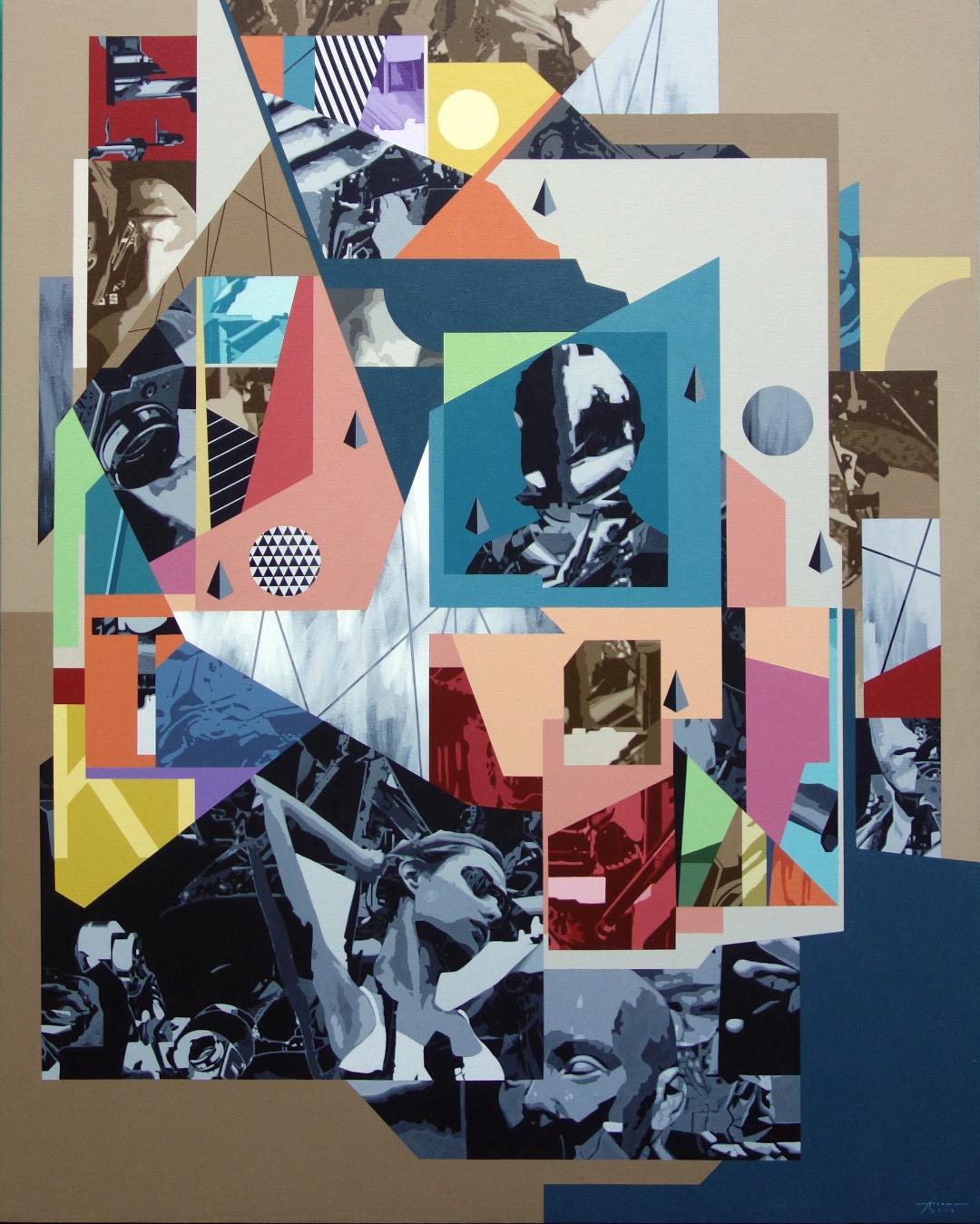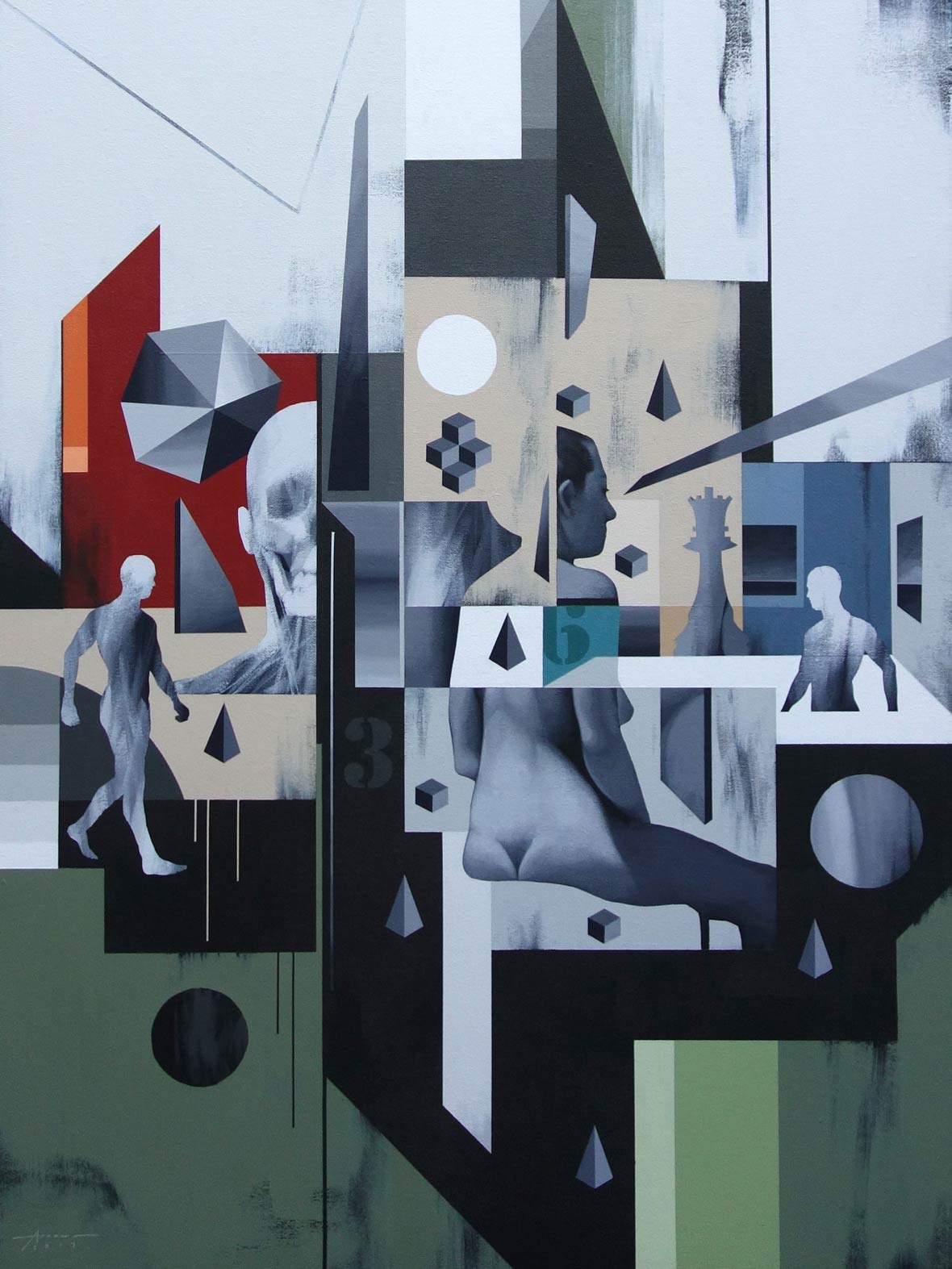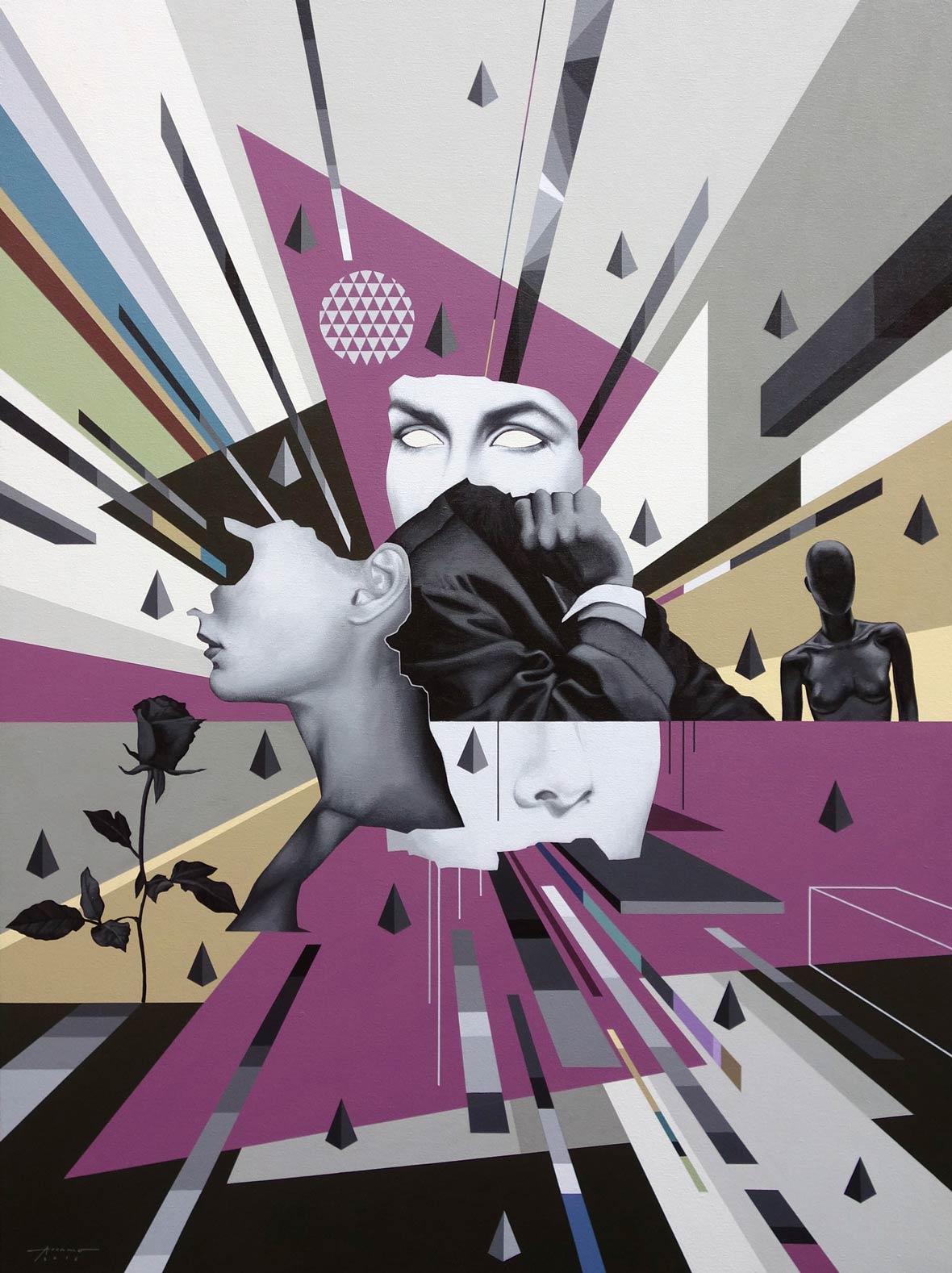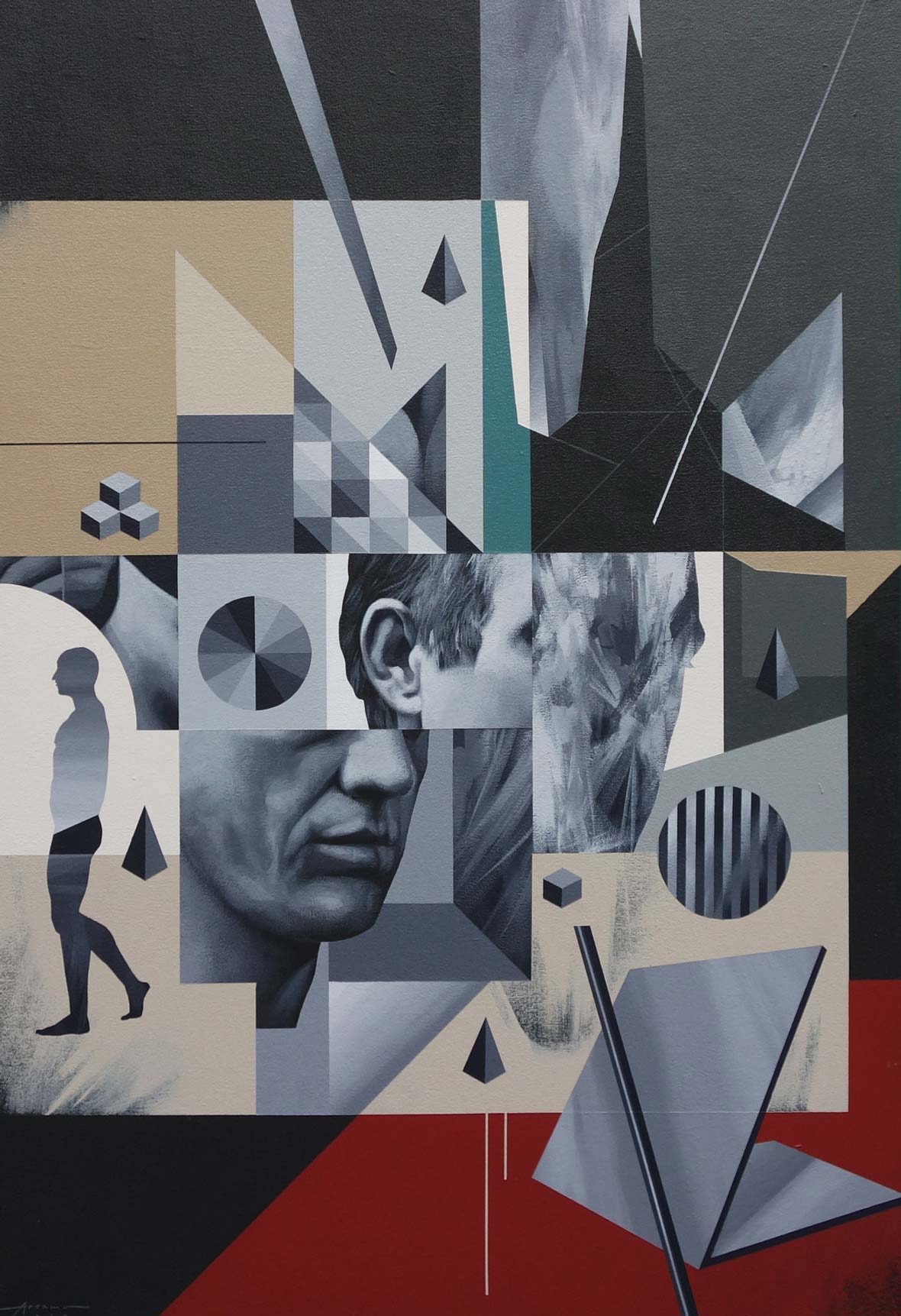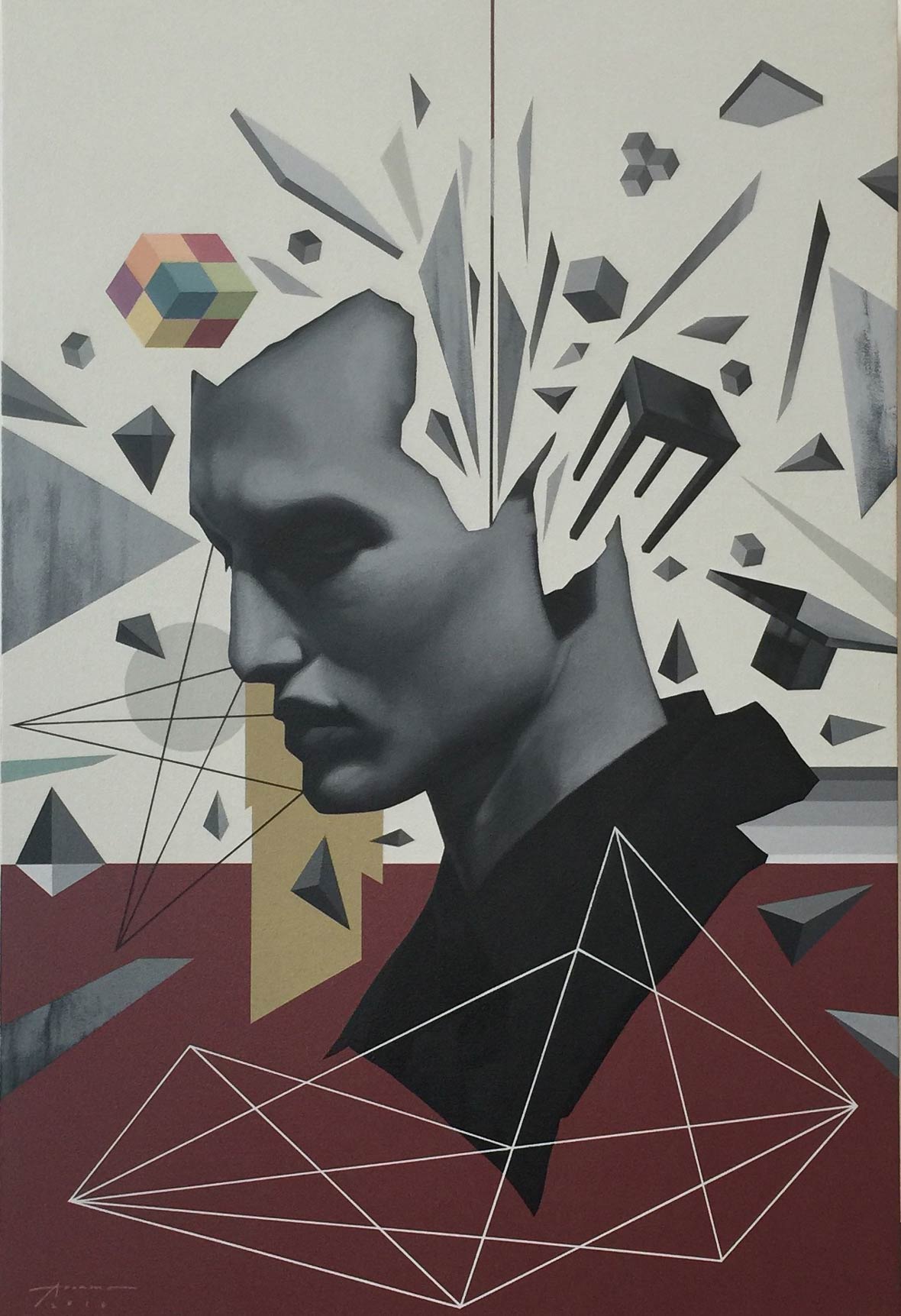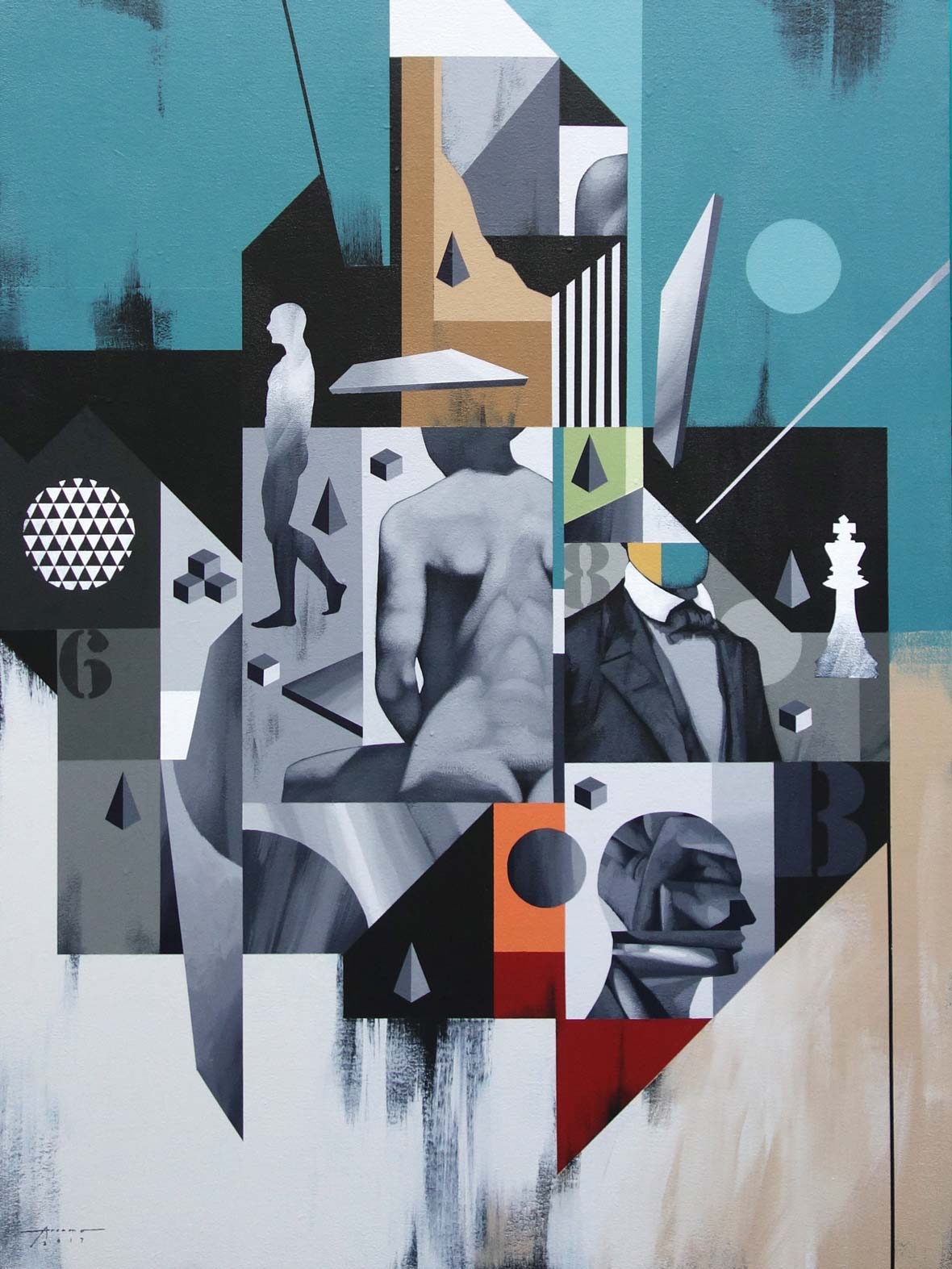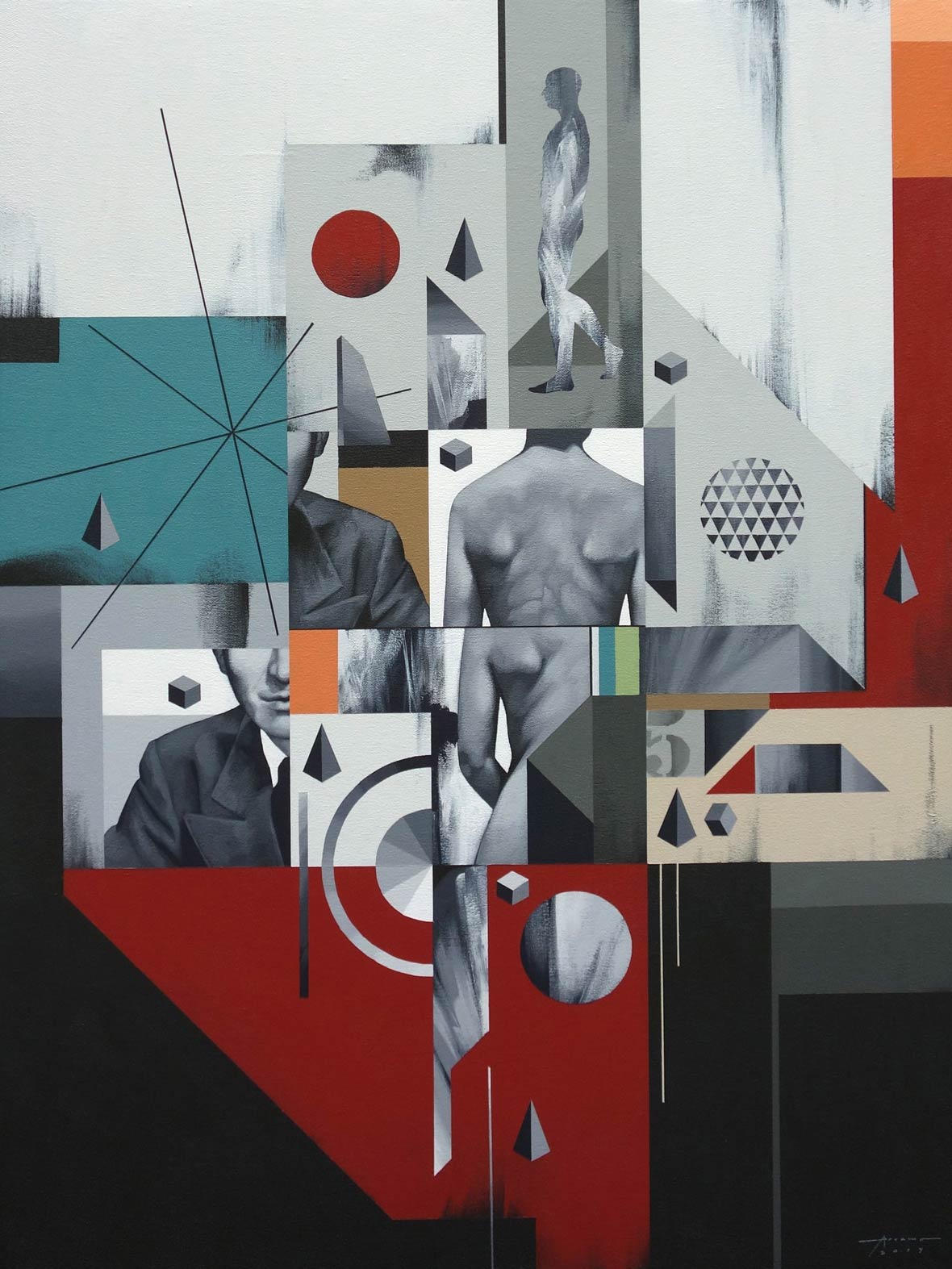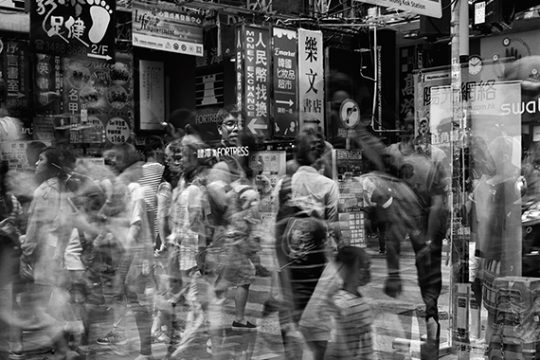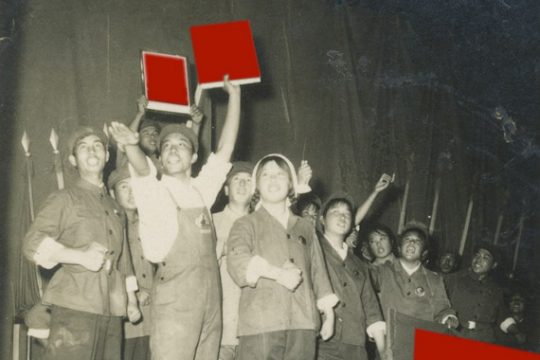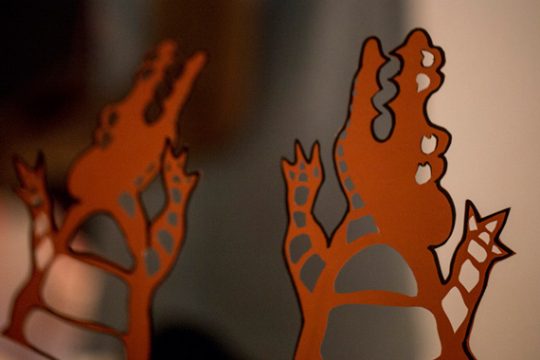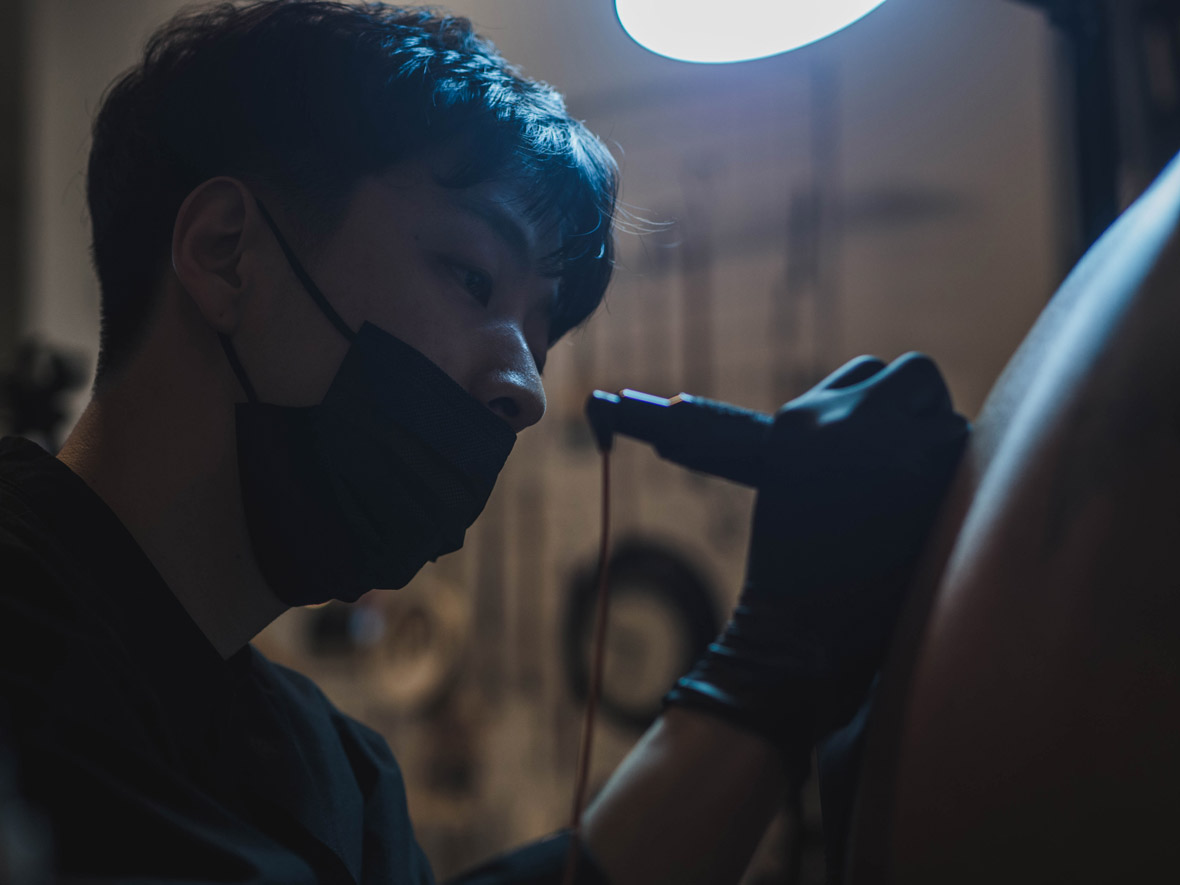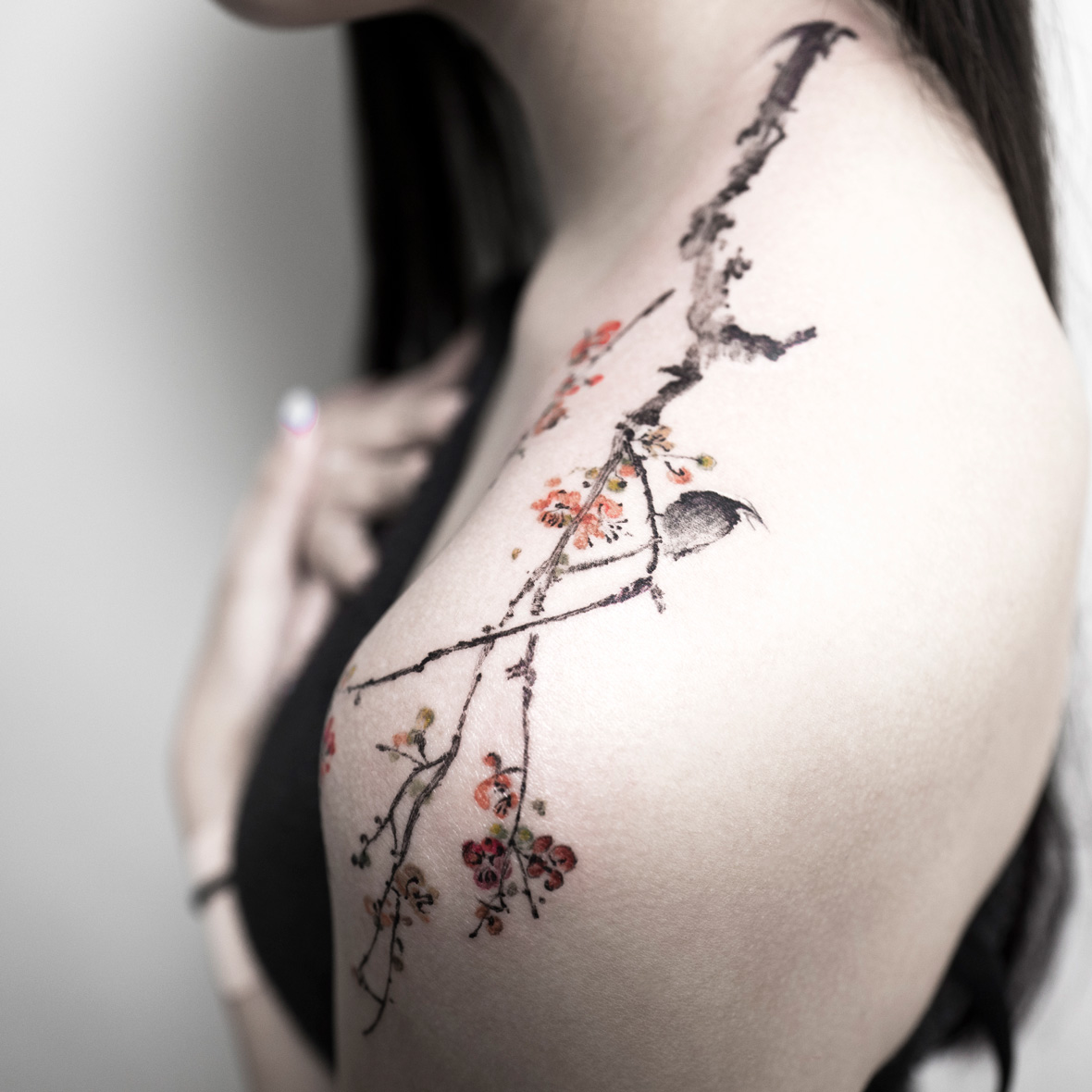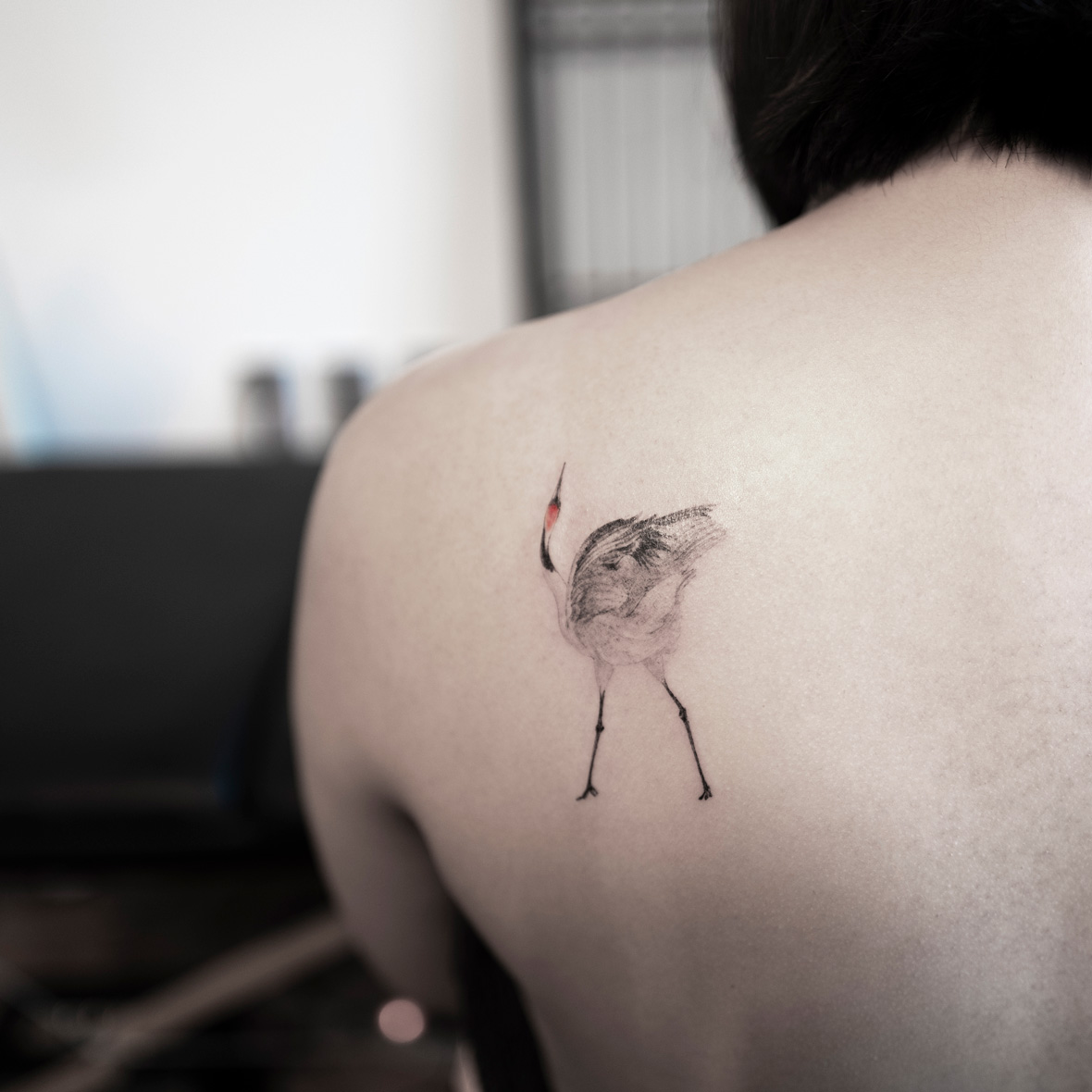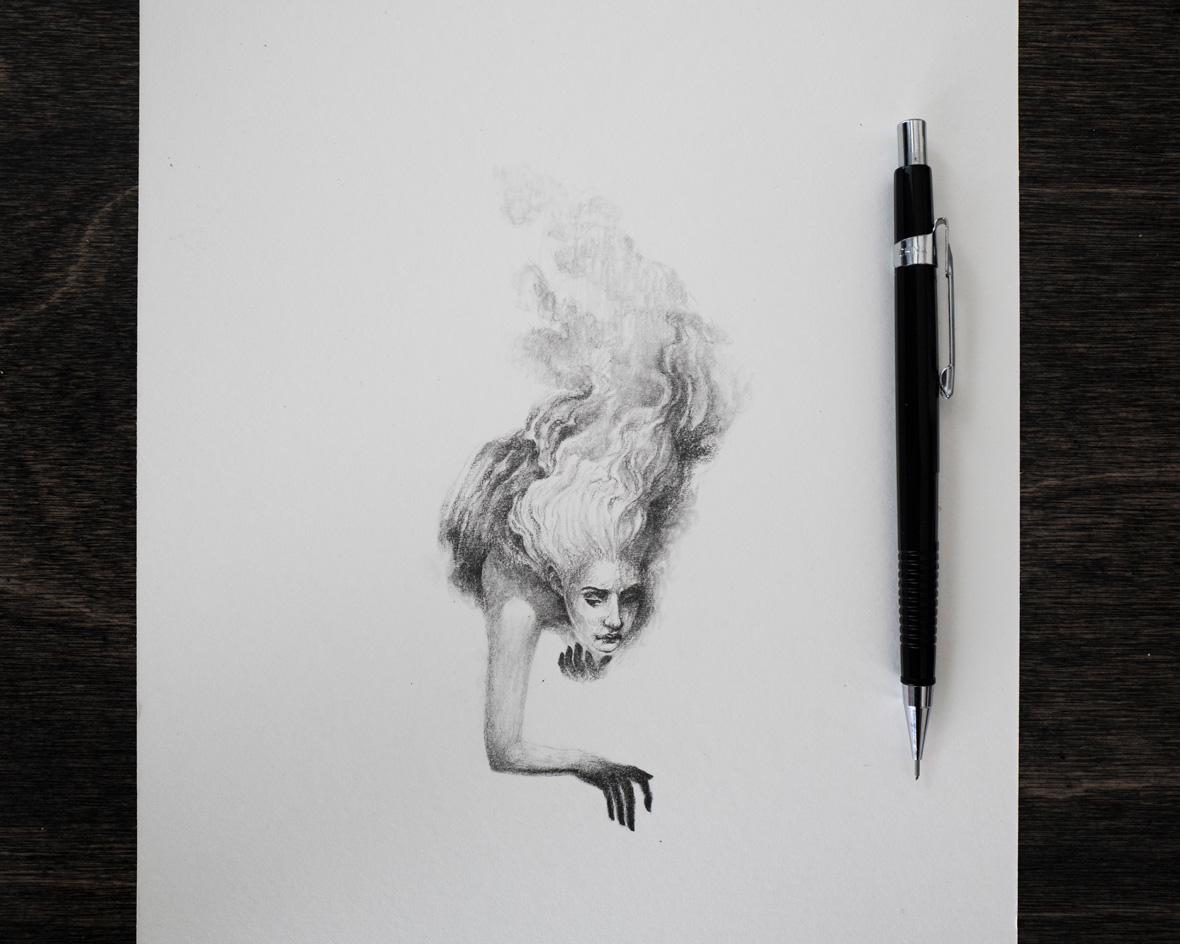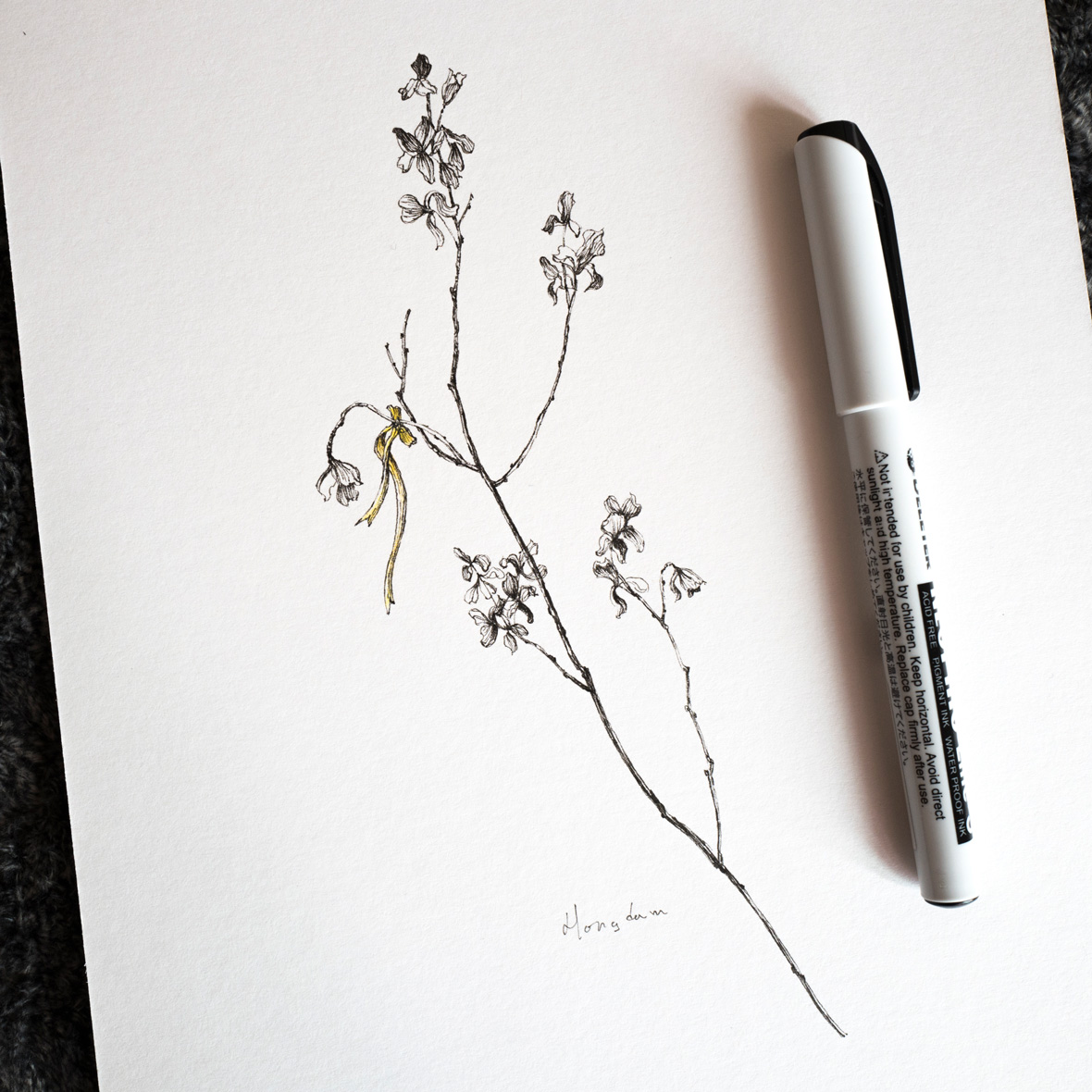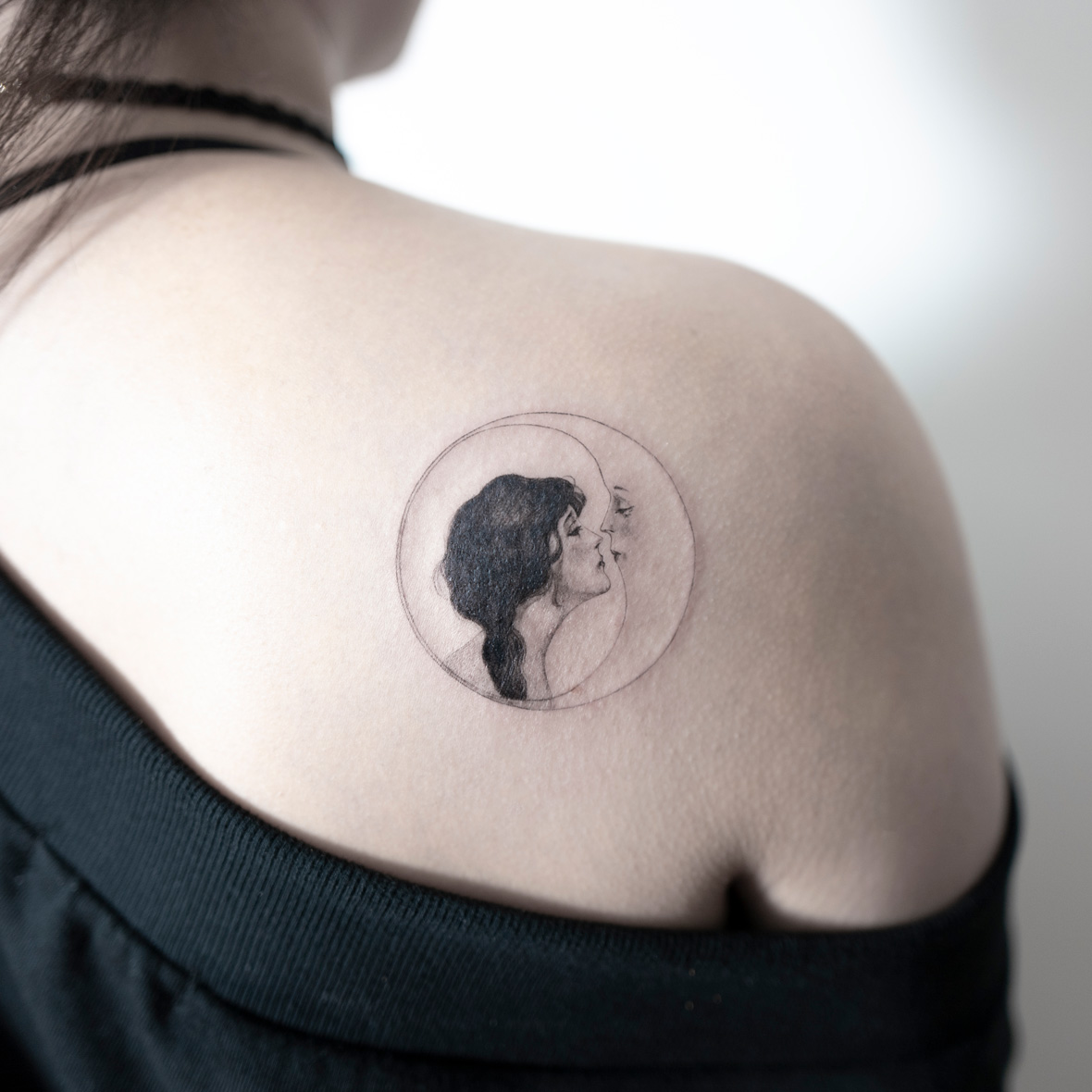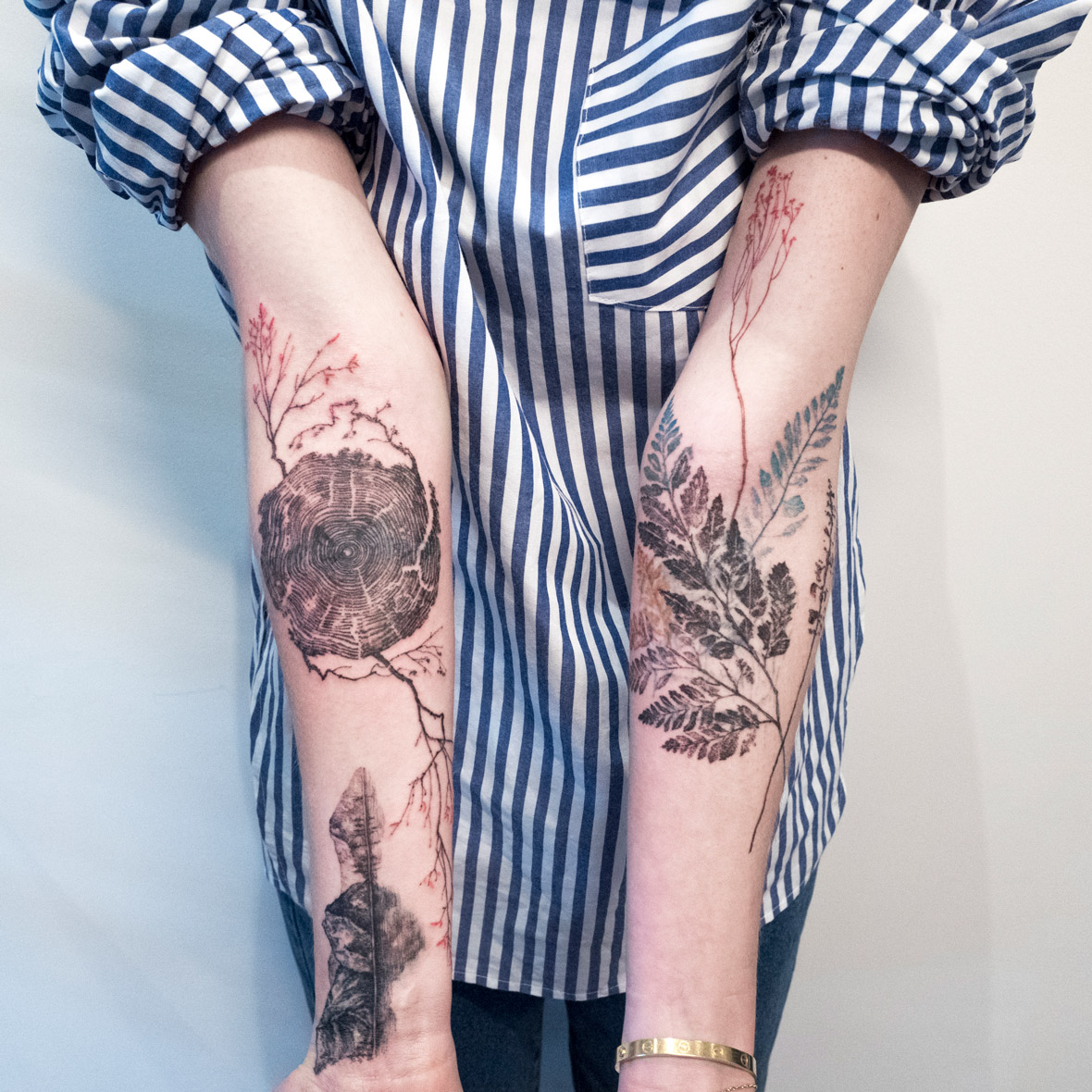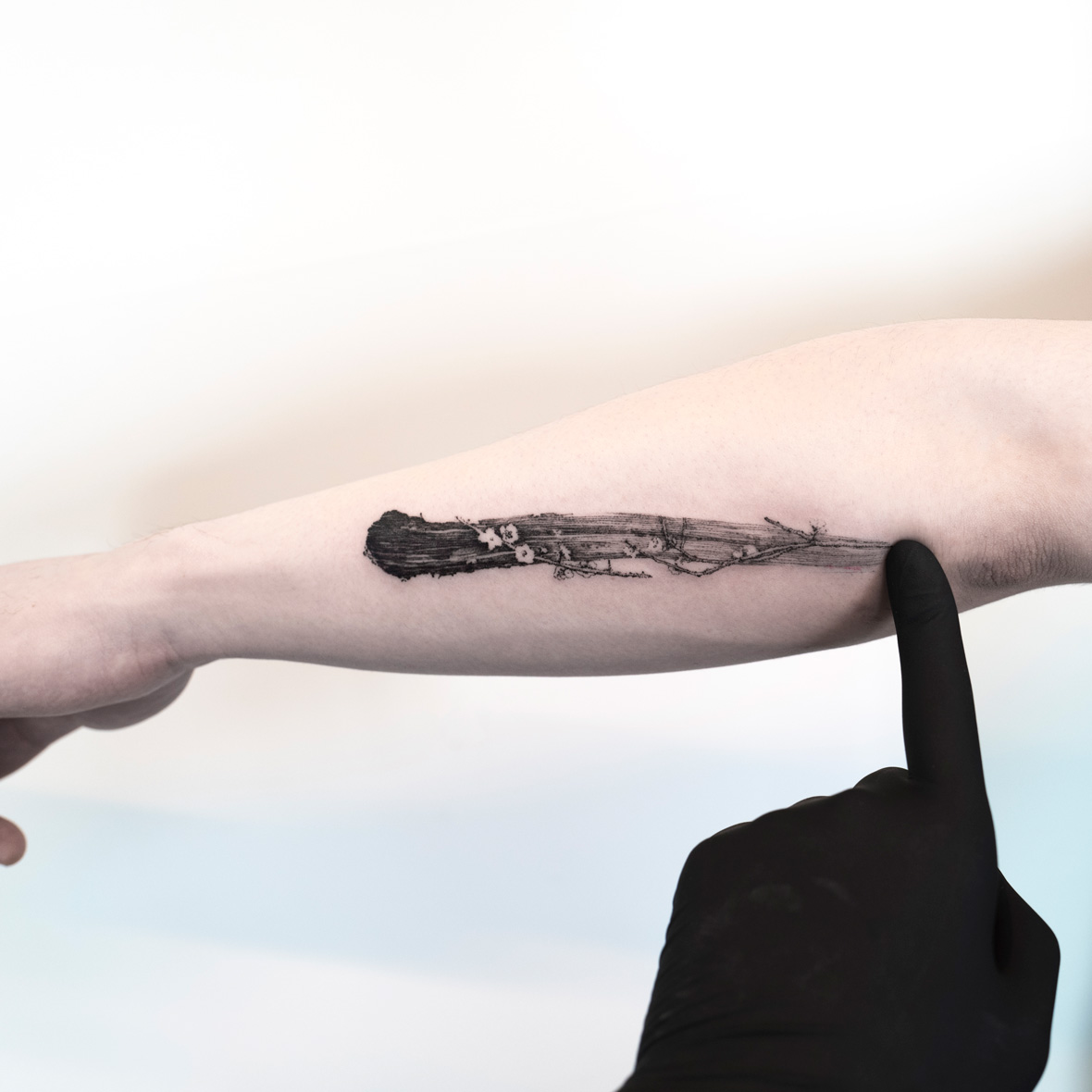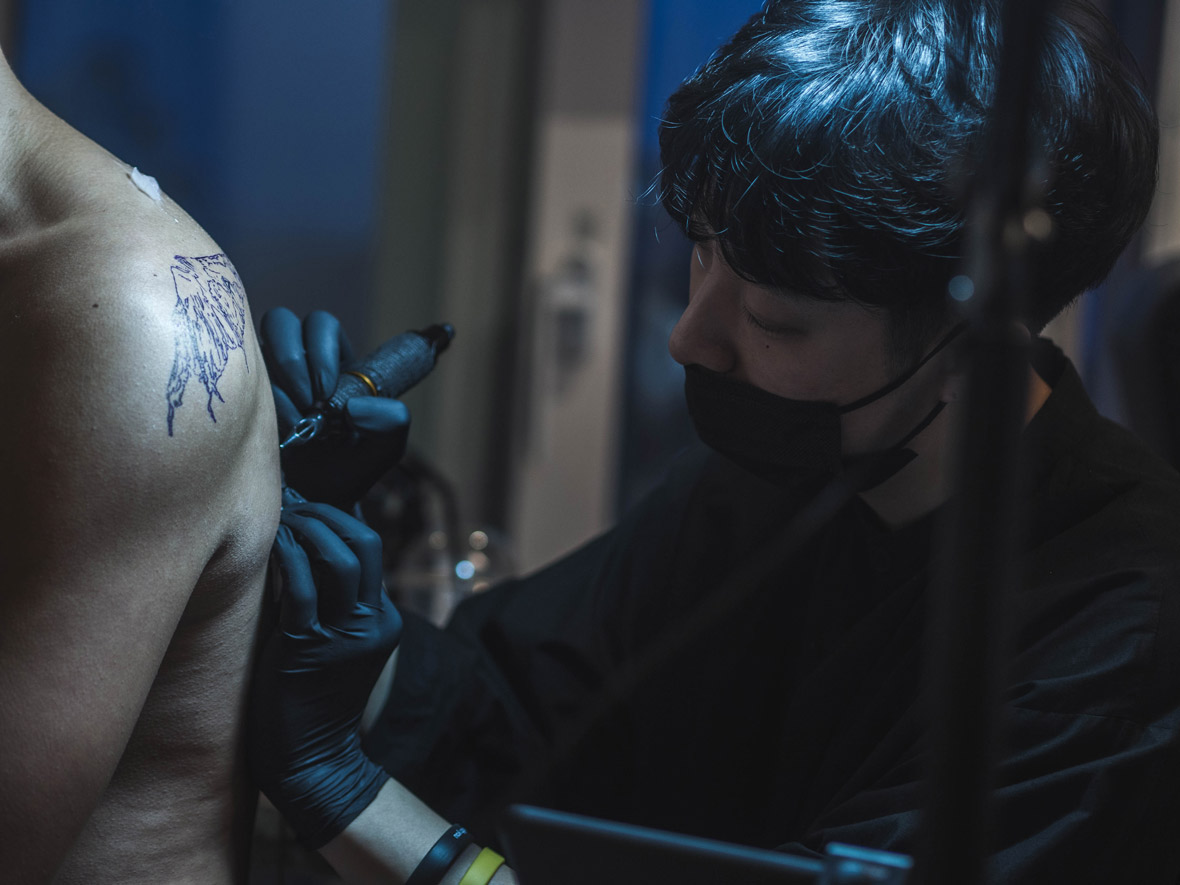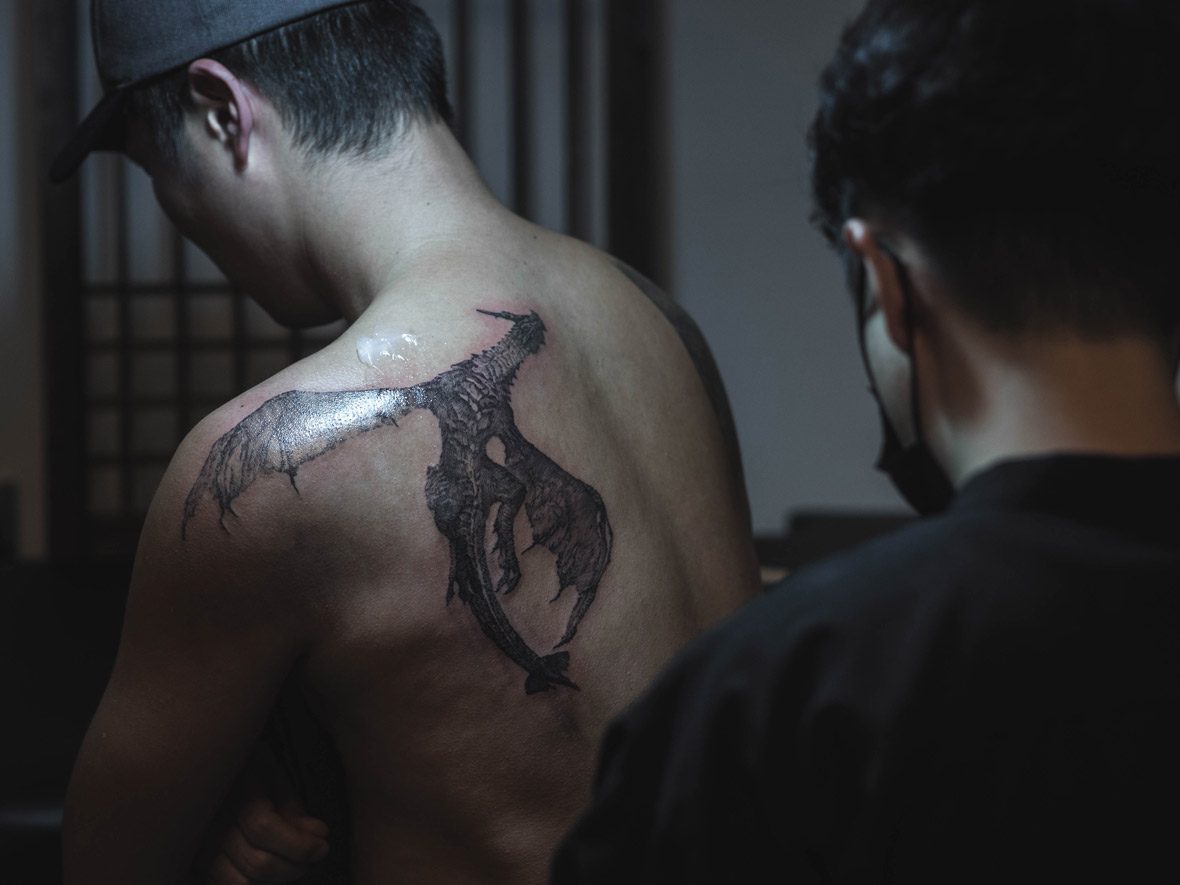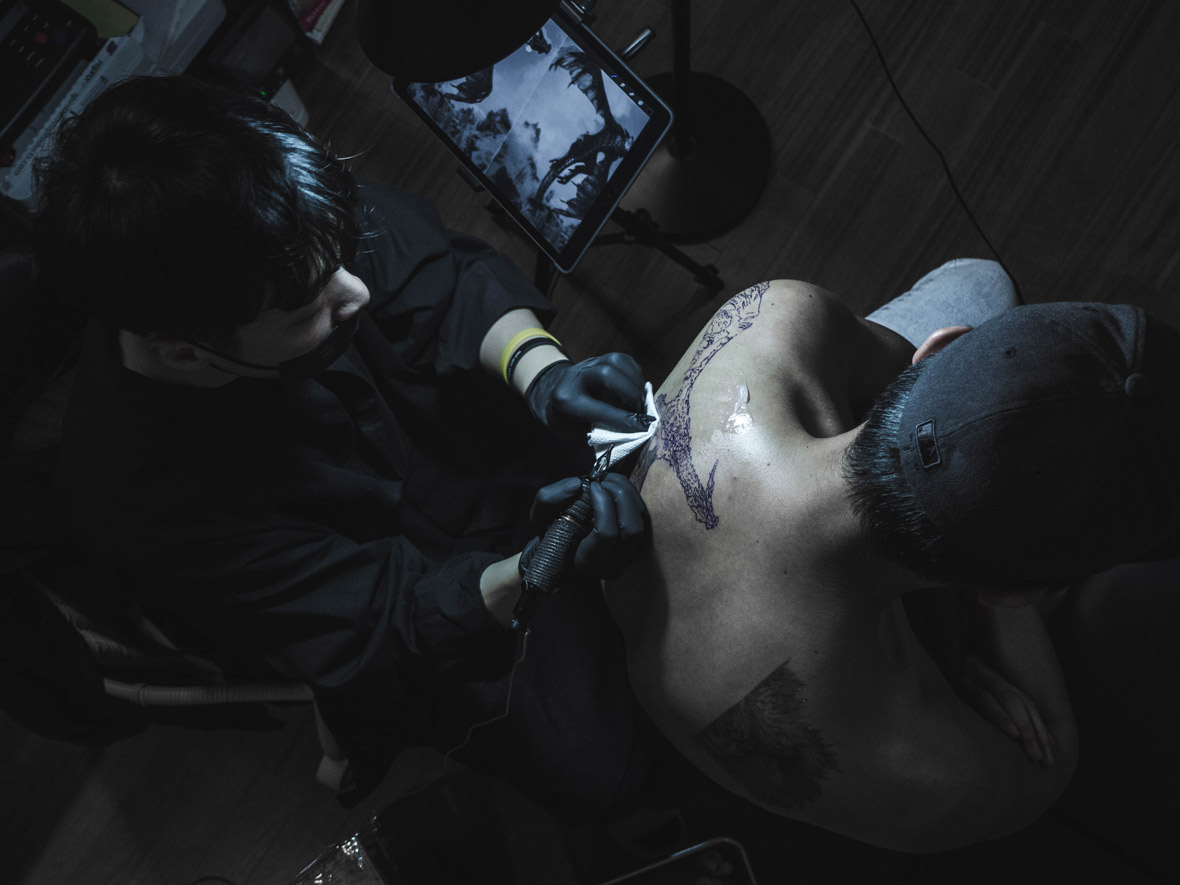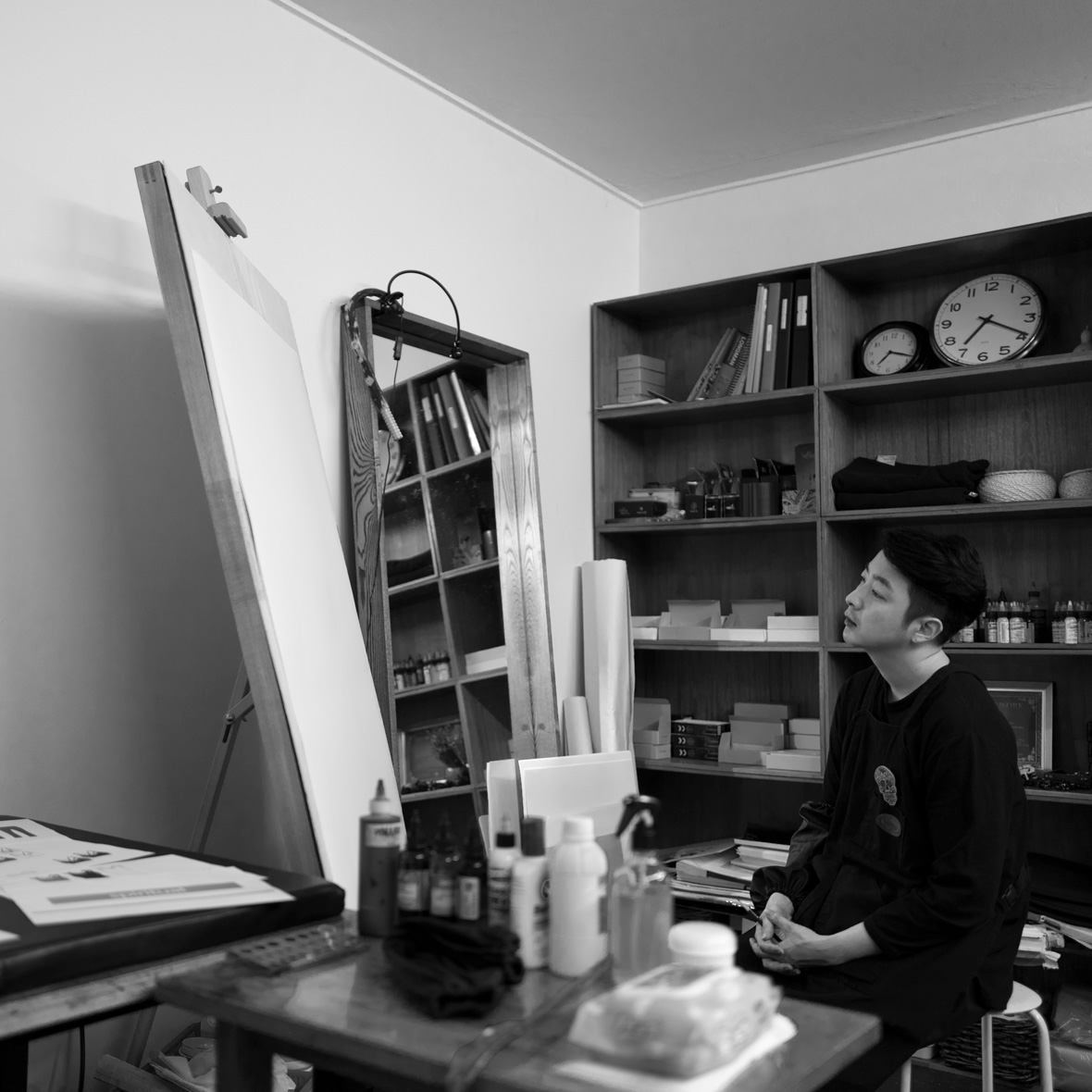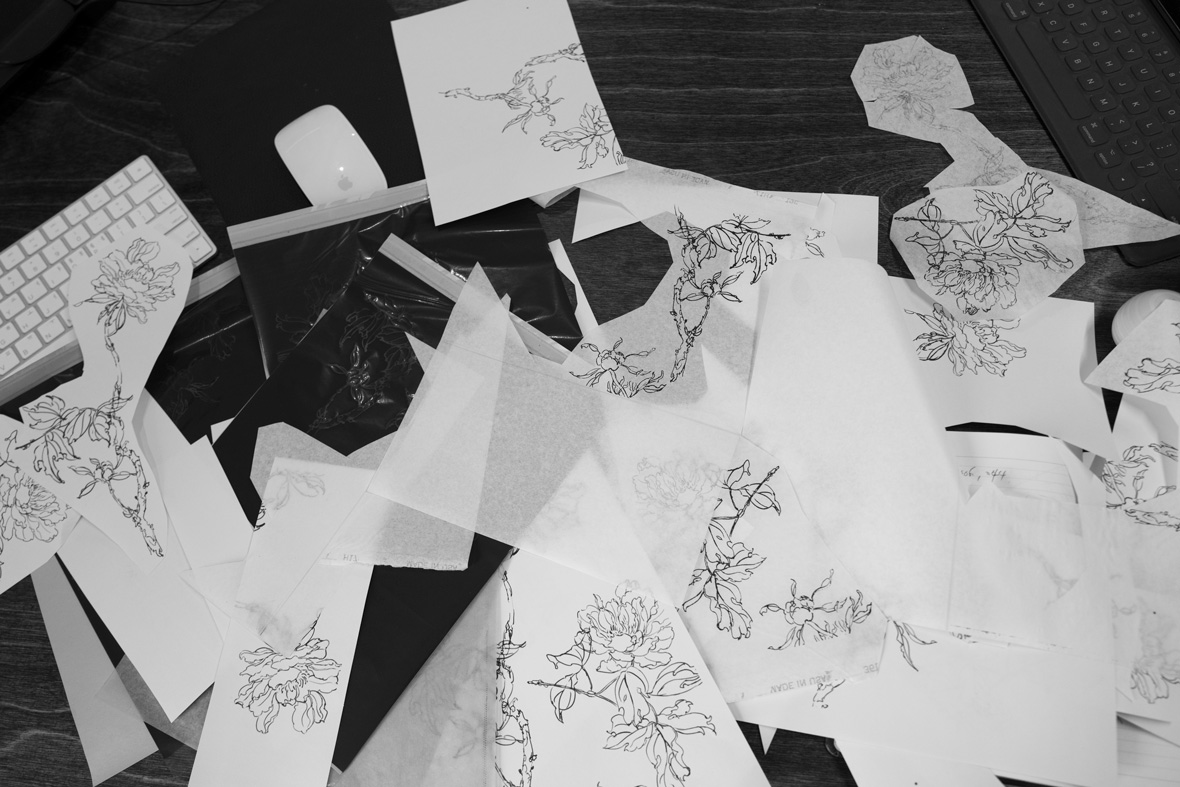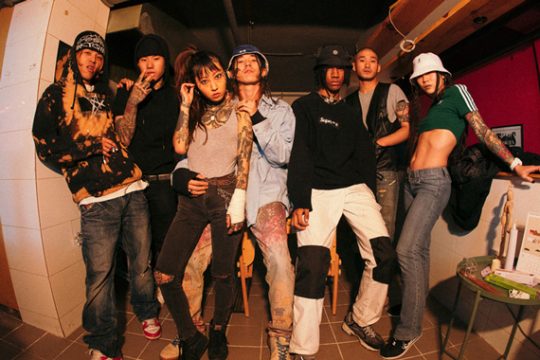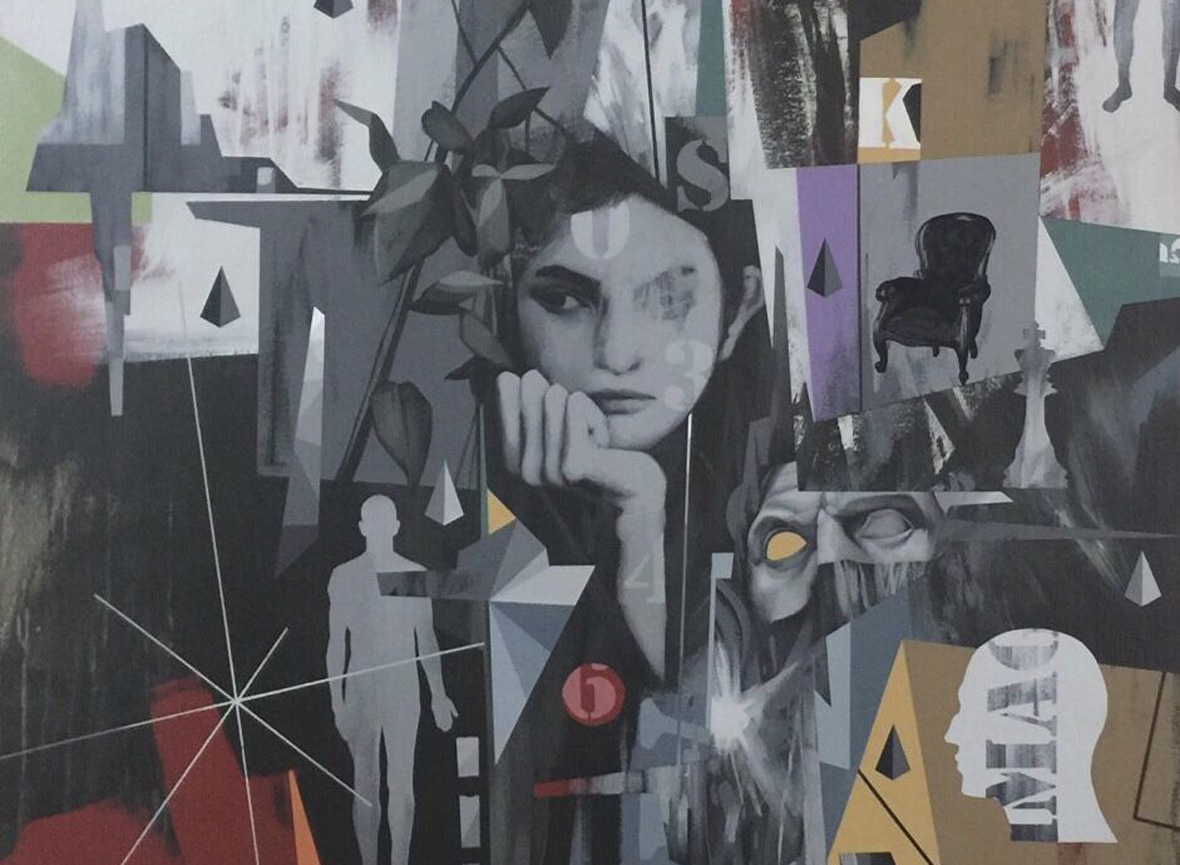
There’s something familiar about Mark Arcamo‘s paintings, a whiff of avant-garde anarchy that recalls the early twentieth century. Jumbles of letters and images crowd together in a chaos reminiscent of Hannah Hoch, while the faceless figures and floating geometric shapes—constants throughout his work—partake of the dream logic of Salvador Dalí or René Magritte.
Arcamo, a contemporary Filipino artist, doesn’t preface his work with the fiery manifestoes of the surrealists or the dadaists, and he may not share their revolutionary temperament. Yet in a quieter way, he does share something of their methods: he too explores a psychological landscape using a private symbolic language all his own.
Mark Arcamo 的画作有一种熟悉感,散发一股20世纪初前卫、自由至上的味道。叠合交错的字母和图像使人想起达达主义艺术家汉娜·霍克(Hannah Höch)的拼贴作品,而贯穿其作品的那些不露面的人像与浮动的几何形状,又展现着超现实主义画家萨尔瓦多·达利(Salvador Dalí)或雷内·马格利特(René Magritte)的梦幻逻辑。
当代菲律宾艺术家 Arcamo 不像超现实主义或达达主义者那样利用作品去引出激进的宣言,他也没有他们那种革命家性格。然而,他以一种更低调的方式,分享着相同的创作手法:用自己独特的符号语言去探讨内在的精神世界。
When choosing his subject matter, Arcamo lets his instincts guide him. “I usually start by collecting random images from books, magazines, the internet, screenshots of movies, television shows, and documentaries, or anything that catches my attention, then I let the goblins in my head take over,” he says. “I’m attracted to the idea of my work having an unpredictable outcome.”
Those images include a series of recurring elements: torsos, chess pieces, men in suits, and—most notably—abstract solids: cubes, cylinders, and pyramids, suspended in mid-air or propelled outward in a sudden blast. “Every element in my work elicits an emotional and intellectual response from me,” he says. Others may not share his personal symbolic vocabulary, but that doesn’t bother him. “As an artist, I want my art to be open to interpretation,” he says.
在选择题材时,Arcamo 总是听任自己的直觉。他说: “我通常都是先在书本、杂志、互联网、电影屏幕截图、电视节目、纪录片或任何吸引我注意的事物上随机收集一些图像,然后任由创意和想像力发挥。最让我着迷的一点是我的作品成果总是无法预期。”
这些图像包括一系列重复的元素: 人体躯干、西洋棋、穿着西装的男人和那些最显而易见的抽象固体形状——悬浮在半空中或呈爆炸状的立方体、圆柱和金字塔等等。他说: “我作品中的每一个元素都能引起我在情绪和思想上的反应。” 其他人可能并不理解他个人的符号语言,但他并不在意。“作为一名艺术家,我希望我的艺术能够让观众有自己的理解。”他说。
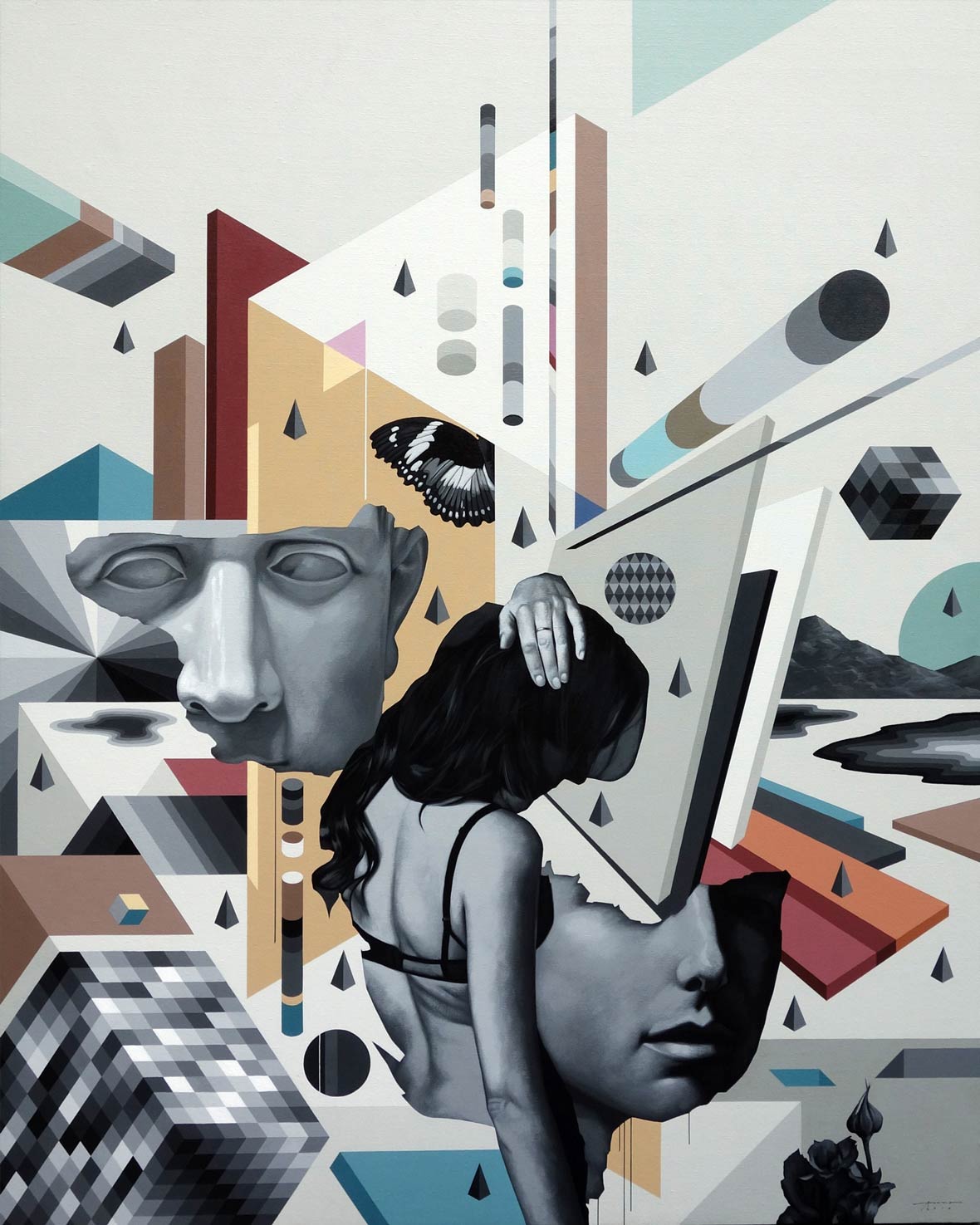
Gray dominates many of these works, sometimes complemented by a matte red or blue, as in Self-Deceived 2. The human figures in particular are nearly always gray, which makes them feel like something from the past—photographs or statues, or recollections that flash by only in fragments. It’s almost as though Arcamo had set out to paint the gears and springs of memory, the mechanisms of mental life.
在他的许多作品中,灰色是主要色调,有时也会辅以黯淡的红色或蓝色,譬如《Self-Deceived 2》这幅作品。画面中的人形几乎全都是灰色,仿佛他们都来自过去的年代,如同闪过脑海的旧照片、雕像或回忆的碎片一样。这几乎就像 Arcamo 要画的是回忆世界的齿轮和弹簧,或者说,精神生活的组成零件。
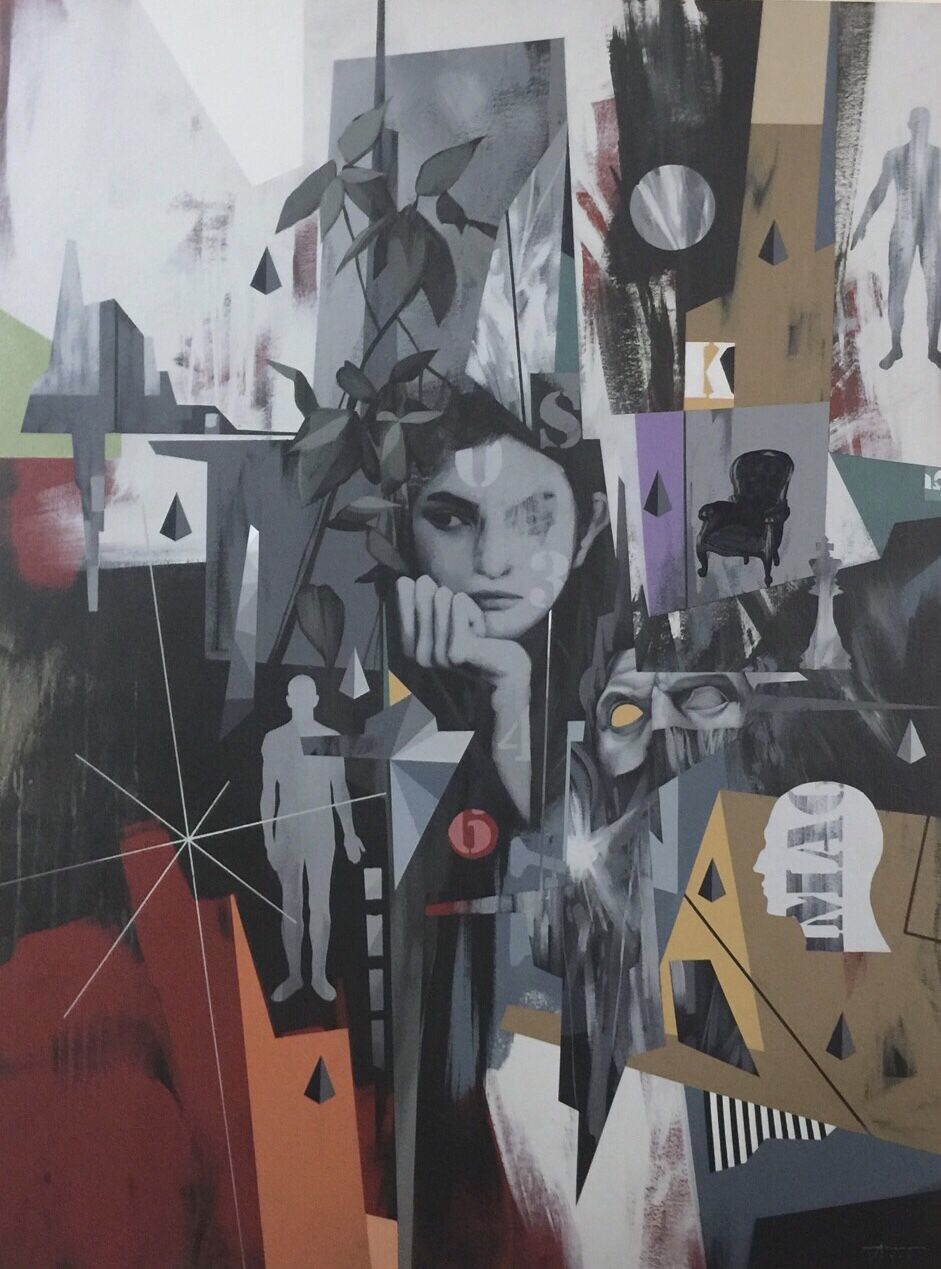
Arcamo loved art as a child, and he studied it formally in college. After graduation, he honed his technique working as a muralist for commercial clients. That’s when he began painting in acrylic. “It allowed me the freedom to experiment and manipulate images. It dried faster and made the job easier to finish,” he says. “At the time, I was also developing my own style—visual collage. As the work dries quickly, I can work in multiple successive layers without muddying the colors.”
Arcamo 从小就喜欢艺术,并在大学里修读了艺术专业。毕业后,他作为壁画师,曾给客户创作作品。也正是那时候起,他开始用丙烯颜料画画。 “这种颜料让我可以自由地去试验和处理图像。它干燥的速度更快,所以我也能更快完成作品。 ” 他说,“同时,我也在慢慢地确立自己的艺术风格——视觉拼贴。因为颜料干得更快,我可以同时连续完成多个图层,也不用怕弄脏颜色。”
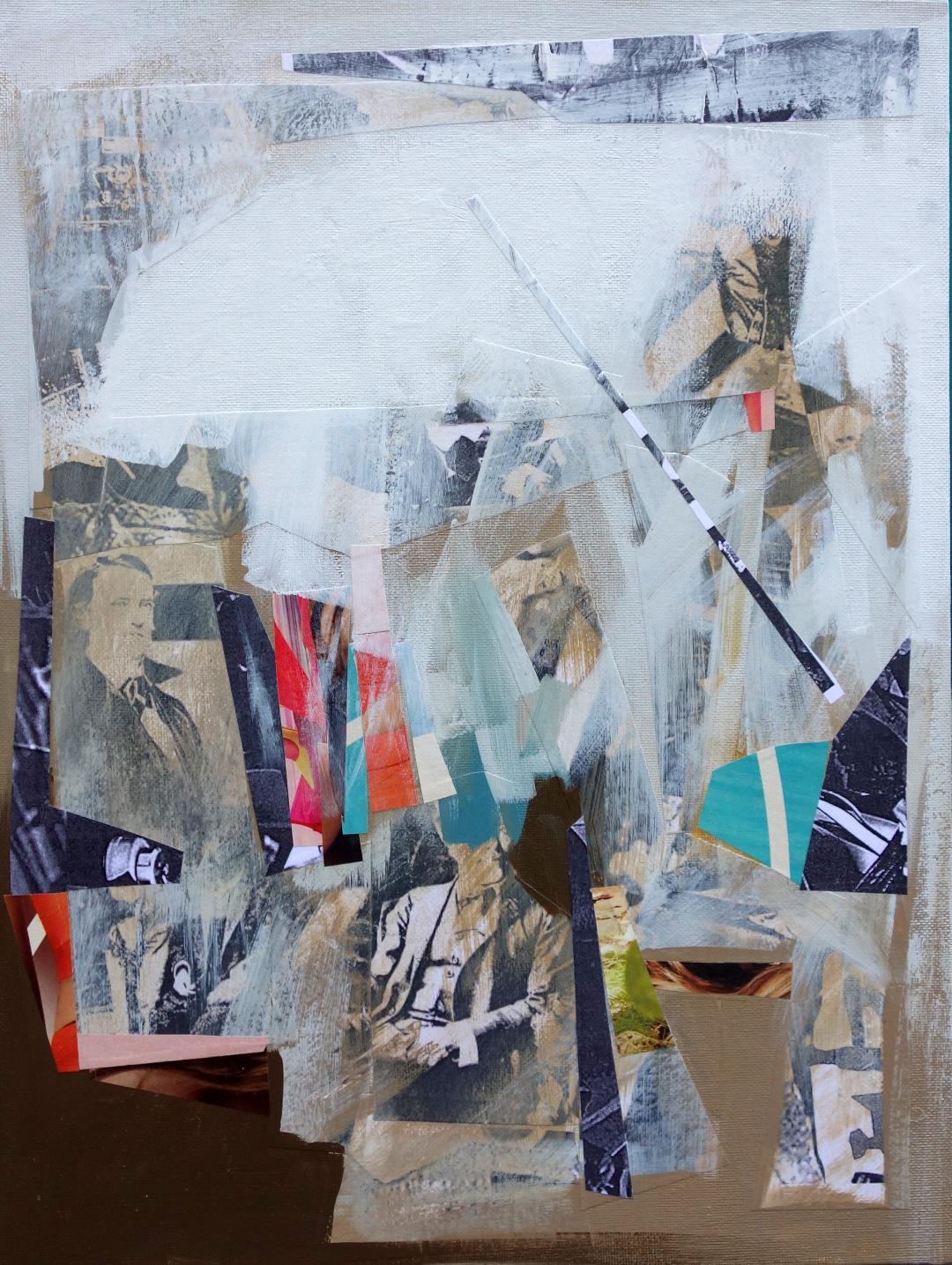
In his recent work, some of which debuted at the 2018 Art Fair Philippines, Arcamo has taken a turn toward the abstract. Image Source 2, for instance, shows a field of white that partly covers a sepia-toned portrait, while narrow strips of other images litter the canvas. The work has rougher edges, without the careful human outlines of his earlier paintings. Gone too are the shattered shapes suspended in dramatic three-dimensional perspectives. In their place is textured, layered flatness that paradoxically seems to have more depth. Compartmentalized is similarly abstract, and bolder in its use of color.
他最近的一些作品于 2018 Art Fair Philippines(菲律宾艺术博览会)首次亮相,看得出来 Arcamo 的创作开始走向抽象。譬如,在《Image Source 2》中,他以一片白色覆盖深褐色人像,而从其它图像剪裁出的窄条则布满了画布。在这幅作品中,和他早期绘画那些精致的人体轮廓不同,画面的边界更为粗糙,也没有了那些在三维视角中戏剧性地悬浮着的几何碎片。取而代之的是有纹理的、分层的平面色块,然而看上去却有更深的层次感。而另一幅作品《Compartmentalized》也采取类似的表现方式,同样抽象,但用色更为大胆。
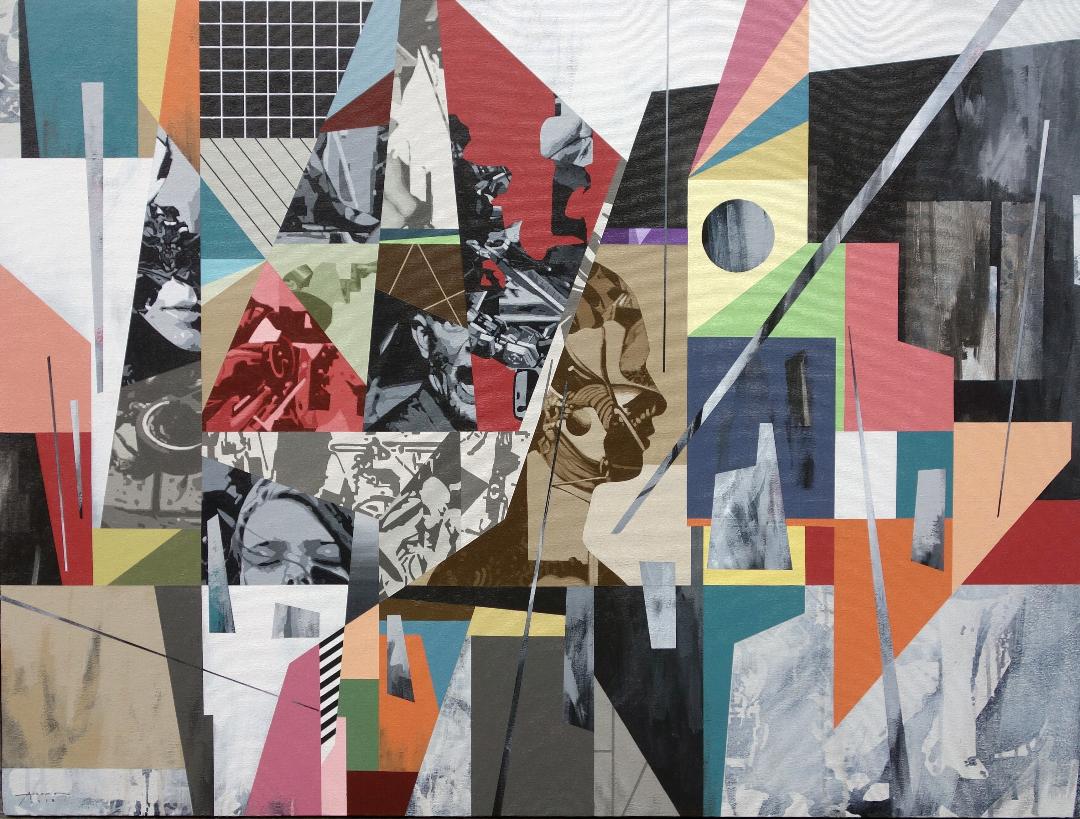
These new collages, like his previous work, make use of a modernist visual idiom. Largely abandoning the human form, they nevertheless remain accessible and engaging. Arcamo seems to be searching for a new balance between color and composition, and the insight his work points to is one that, a century ago, avant-garde artists knew well: sometimes abstraction, more than representation, can deepen a work’s emotional power.
和他之前的作品一样,这些拼贴画新作也同样利用了现代主义的视觉语言。它们在很大程度上放弃了人类的轮廓,但仍然能让人理解,也十分引人入胜。Arcamo 似乎在寻找色彩和构图之间的新平衡,他的作品响应着一个世纪前,前卫艺术家的理念:有时抽象比写实更能加深作品的情感力量。
